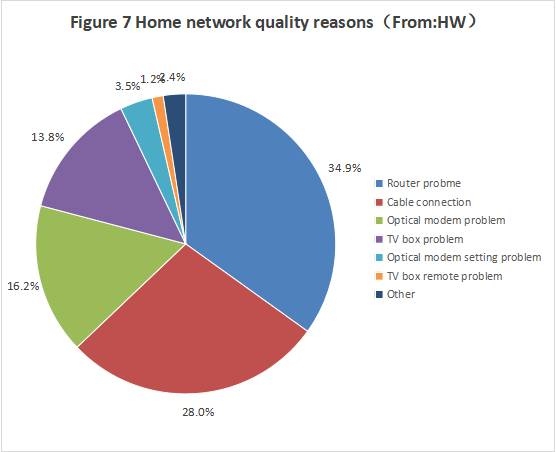As of the end of 2020, the penetration rate of household broadband in my country has reached 96%, and the market has become saturated. The competition focus of operators has shifted from user growth to quality improvement. Initially, operators were only responsible for broadband access (to optical modems ONU/ONT). With the development of services such as IPTV, the internal network of the home has also become the focus of operation and maintenance. Due to users’ lack of network knowledge and residential environment restrictions, home network quality issues account for 60% of home broadband failures, becoming the main reason affecting the experience.
Composition of home network
Home network usually consists of optical modem, router, IPTV cable box (hereinafter referred to as TV box), which is mainly divided into two types of connection cables: optical modem-router and optical modem-TV box-TV, as shown in Figure 1. Home network without IPTV service does not have wired connection from optical modem to TV box.
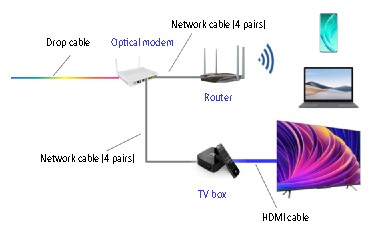
The router and tv box are connected to the optical modem via an Ethernet cable. The mobile phones, pads, computers and other terminals are connected to the router via wifi, and the TV is connected to the TV box via an HDMI cable. The network cable is a 4-pair twisted cable, including Cat5, Cat5e, and Cat6 cables. However, most optical modems have built-in wifi function, but the wifi performance is relatively weak because they are installed in home information boxes, which is not convenient for wifi signal coverage in residential areas, so most home networks use routers as APs (wireless access points). There are also a small number of home networks that do not have routers and directly use optical modems with wifi functions as APs, whom usually have IPTV services.
Main quality issues of home network
Currently, the terminals of home broadband services are mainly: TVs, computers, mobile phones and other IoT devices. Since IPTV services do not occupy the contracted bandwidth, other terminals except IPTV are generally connected to the Internet through wifi; therefore, the wifi speed of the daily use point of the user terminal in the residence directly affects the user experience.
We selected 39 households in a eastern city H and 27 households in a southern city F, and tested the wifi speed in the residences (test time: H city January 2021, and F city August 2022). The wifi downlink speed near the Wifi router is called wifi bandwidth. Usually, the wifi bandwidth is considered qualified if it reaches 90% of the contracted bandwidth. However, in the test, it was found that the wifi bandwidth qualification rate of home broadband users in H City and F City was only 33.3%, of which 100M users were 40.1%, and 200M and above users were 26.5%. The ratio of wifi bandwidth to contracted bandwidth of 66 users in H City and F City is shown in Figure 2.
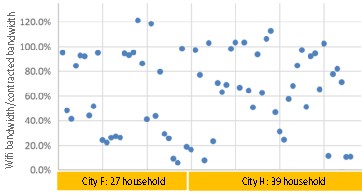
We continued to test the Wi-Fi speeds of the 66 user terminals in their homes. Each household tested 4 to 6 daily use points. The locations of the test points can be found in the article “Survey of Wi-Fi Speeds in 39 Home Broadband Users”. The speed test results of different test points are shown in Figure 3.
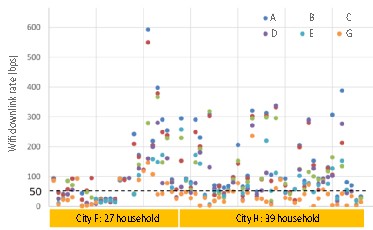
Wifi speed is linearly related to wifi bandwidth. Due to the low wifi bandwidth qualification rate, although the average contracted bandwidth of the above users is as high as 262.1Mbps, the wifi speed of daily use points in the user’s residence is not fast. The distribution of wifi speed of daily use points of user terminals in 66 user residences is shown in Table 1.
| Wifi downlink speed(Mbps) | Ratio |
| ≤20 | 12.6% |
| >20,≤50 | 25.0% |
| >50,≤100 | 35.7% |
| >100,≤200 | 13.2% |
| ≥200 | 13.5% |
It can be seen from Figure 2 and Table 1 that low Wi-Fi bandwidth qualification rate and low Wi-Fi speed are the main quality issues of home networks.
Analysis of the causes of home network quality problems
The quality of a home network is mainly related to the performance of home network devices, the connection between devices, the quality of Wi-Fi signals in the home, and user usage.
4.1 Device performance
The performance of devices that have a greater impact on Wi-Fi speed mainly includes: the bandwidth capacity of the router, the bandwidth capacity of the optical modem, and the stability of the device.
4.1.1 Bandwidth capacity of Router
Some older routers have poor bandwidth capacity:
(1) The WAN port only supports a maximum of 100Mbps.
(2) Wi-Fi only supports 2.4G single-frequency; the maximum download rate supported by a 2.4G single-frequency router is affected by the number of router antennas and the same-frequency interference in the use environment. The maximum rate generally does not exceed 200Mbps.
4.1.2 Bandwidth Capacity of Optical Modems
The bandwidth capacity issues of old optical modems are similar to those of routers:
(1) The LAN port only supports a maximum of 100Mbps.
(2) The Wi-Fi of the optical modem only supports 2.4G single-frequency; when the optical modem is used as an AP, the 2.4G single-frequency optical modem will restrict the Wi-Fi speed.
4.1.3 Equipment Stability
Some models of optical modems and TV boxes have poor stability, which can easily lead to network failures. Routers are usually purchased by users themselves, and some cheaper routers have poor stability.
4.2 Connection between devices
4.2.1 Connection between router and optical modem
(1) The TV box and router share a network cable. Many users install the optical modem in the home information box and place the router next to the TV. However, there is usually only one network cable from the home information box to the TV. During installation, the maintenance personnel often divide the 4 pairs of network cables into two groups, each with two pairs of cables, which are connected to the router and the TV box respectively, as shown in Figure 4. Although this is usable, the two pairs of cables only support a maximum transmission rate of 100Mbps.
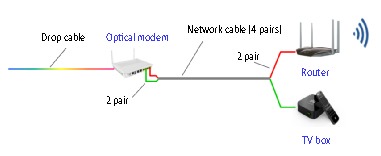
(2) The LAN port of the Gigabit optical modem is connected incorrectly. The LAN port of a Gigabit optical modem usually includes 1 Gigabit port and 1~2 100M ports, as shown in Figure 5 (the yellow interfaces in the figure are: Gigabit LAN, 100M LAN, 100M LAN and IPTV). The identification of the Gigabit port and the 100M port is not obvious, which leads to user connection errors.
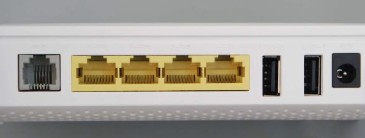
(3) Poor-quality network cables. Some households use low-quality network cables or old lower speed network cable, which results in the transmission rate between the optical modem and the router being difficult to exceed 100Mbps.
4.2.2 Uplink of TV box
The bandwidth of the TV box does not occupy the user’s contracted bandwidth, and should be connected to the IPTV interface of the optical modem with a network cable. However, some users’ TV boxes are connected via wifi, so the cable TV box occupies the user’s contracted bandwidth, which will have a greater impact on the Internet speed of users with a contracted bandwidth of 100Mbps or less.
4.3 Wi-Fi signal quality in the residence
The Wi-Fi signal quality can be reflected by the ratio of Wi-Fi downlink rate to Wi-Fi bandwidth (%) at the optical terminal location. Taking the Wi-Fi signal test results of the above 66 households as an example, the download rate of test point A is equivalent to the Wi-Fi bandwidth, and the signal quality of other test points is shown in Figure 6.
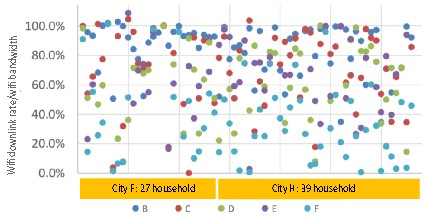
As can be seen from Figure 6, the quality of WiFi signals in residential areas is generally good, but the proportion of WiFi signal quality at test points below 20% still reaches 8.7%.
4.4 User usage
The main reasons related to user usage include: use of the wifi 5G frequency band, long continuous use of the device, and too many terminals connected to the AP.
4.4.1 The 5G band of Wi-Fi is not used.
Since some devices must use the 2.4G band for Wi-Fi connection, the user’s dual-band router or dual-band optical modem is often set to two different Wi-Fi subnets. When using, the user does not pay attention to the difference between the two Wi-Fi subnets and does not connect to the 5G band Wi-Fi subnet, resulting in limited network speed.
4.4.2 The device is used for a long time continuously.
Everyone has this experience, if the mobile phone or computer is not turned off for a long time (for example, more than 10 days), the operation will slow down. Just restart it. The same is true for routers, optical modems, and TV boxes in the home network. If they are used for a long time, the operation of the device will become slower and slower, causing users to surf the Internet.
4.4.3 Too many terminals connected to the AP.
The ability of the AP to access wifi terminals is related to the performance of the AP. When the AP is an optical modem or some low-end routers, the number of wifi terminals that can be connected at the same time is generally about 10, while with high-end routers is usually more than 20. When the number of terminals connected to the AP does not match the access capability, the user’s Internet experience will also be poor.
Conclusion
The ability of the AP to access wifi terminals is related to the performance of the AP. When the AP is an optical modem or some low-end routers, the number of wifi terminals that can be connected at the same time is generally about 10, while with high-end routers is usually more than 20. When the number of terminals connected to the AP does not match the access capability, the user’s Internet experience will also be poor.
According to the analysis results of the causes of home network quality problems of a certain operator in several provinces, it can be found that the performance of equipment and the connection between devices are the most important factors affecting the quality of home networks in various places.
